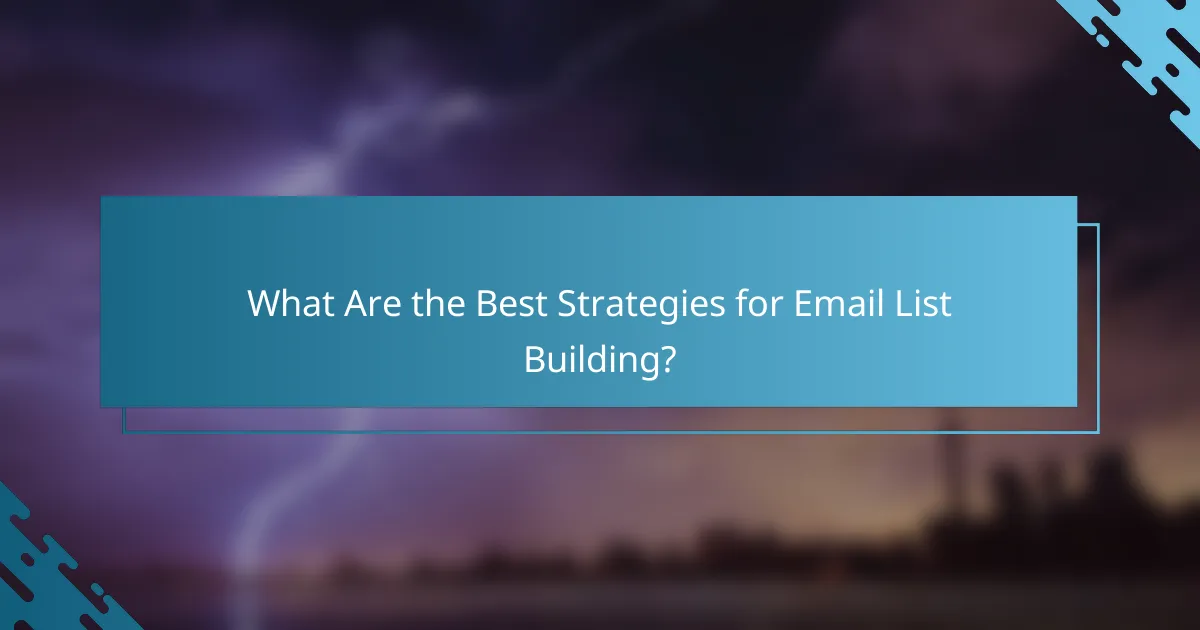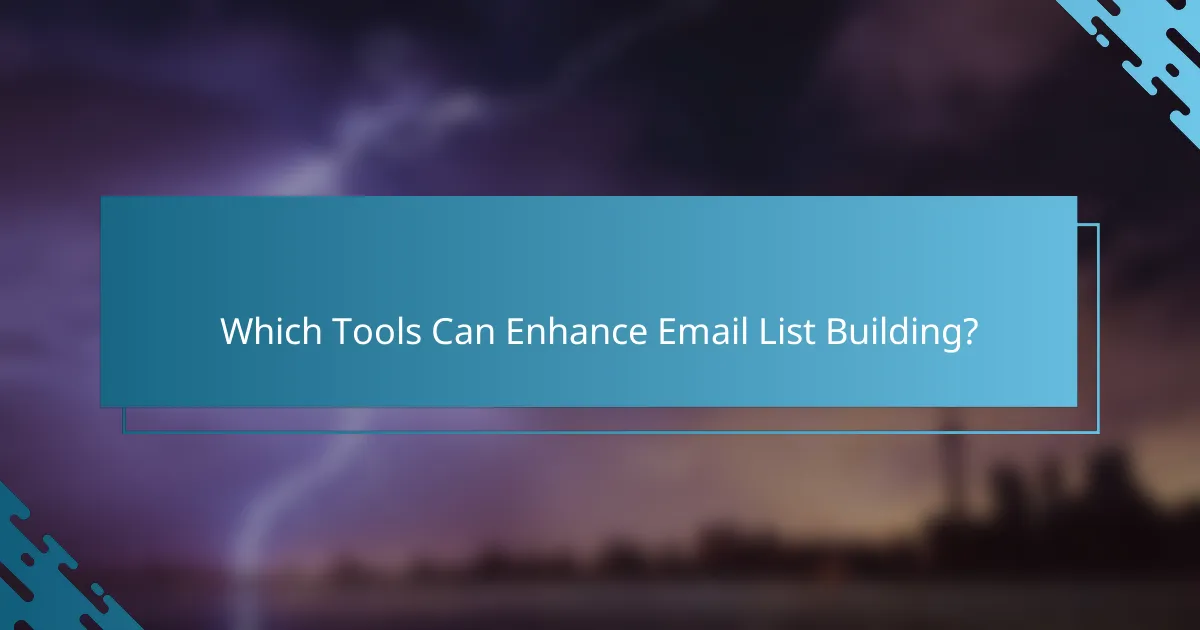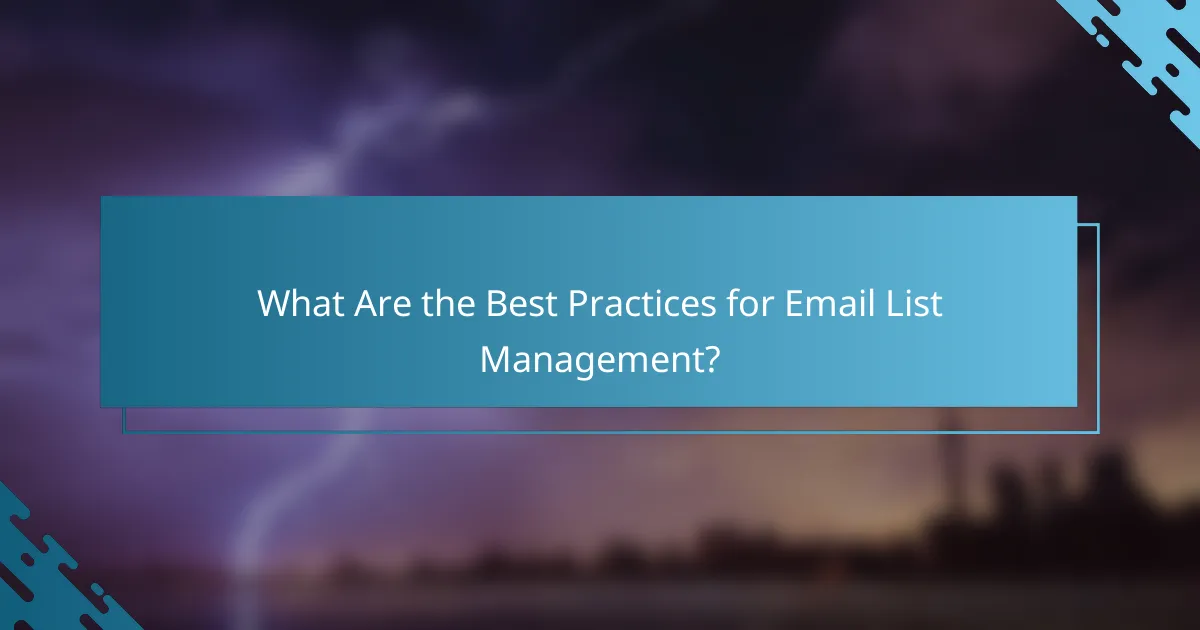Email list building is essential for effective digital marketing, focusing on attracting and retaining subscribers through value-driven strategies. By leveraging the right tools and optimizing sign-up forms, businesses can significantly enhance their list growth and engagement rates, ultimately leading to more successful campaigns.

What Are the Best Strategies for Email List Building?
The best strategies for email list building focus on attracting and retaining subscribers through value-driven tactics. Implementing effective methods can significantly enhance your list growth and engagement rates.
Content upgrades
Content upgrades are targeted offers that enhance existing content, encouraging visitors to subscribe in exchange for additional resources. For example, if you have a blog post about social media marketing, you could offer a downloadable checklist or guide as a content upgrade.
To implement this strategy, identify high-traffic posts and create relevant upgrades that align with the content. Ensure the upgrade is easily accessible, typically through a simple form that collects the subscriber’s email address.
Lead magnets
Lead magnets are incentives designed to attract potential subscribers by offering something of value, such as eBooks, free trials, or discount codes. A well-crafted lead magnet can significantly increase your conversion rates.
When creating a lead magnet, focus on your target audience’s needs and preferences. Make sure the offer is compelling enough to encourage sign-ups, and promote it across your website and social media channels.
Social media promotions
Social media promotions can effectively drive traffic to your email sign-up forms. By sharing engaging content and exclusive offers on platforms like Facebook, Instagram, or LinkedIn, you can attract followers to join your email list.
Consider running contests or giveaways that require participants to subscribe to your email list for entry. This not only boosts your subscriber count but also increases engagement with your brand.
Webinars and events
Hosting webinars and events can be a powerful way to build your email list. By offering valuable insights or training sessions, you can attract attendees who are interested in your expertise.
To maximize sign-ups, promote your webinars through various channels and require registration via email. Follow up with attendees afterward to nurture the relationship and encourage further engagement.
Referral programs
Referral programs incentivize existing subscribers to refer new subscribers, creating a network effect that can rapidly grow your email list. Offering rewards, such as discounts or exclusive content, can motivate your audience to spread the word.
Design a simple referral system where subscribers can easily share a unique link or code with their network. Track referrals and ensure rewards are delivered promptly to maintain enthusiasm and participation.

Which Tools Can Enhance Email List Building?
Several tools can significantly enhance your email list building efforts by streamlining processes and improving engagement. Selecting the right tool depends on your specific needs, such as automation, design capabilities, and integration with other platforms.
Mailchimp
Mailchimp is a popular email marketing platform that offers robust list-building features. It provides customizable sign-up forms, landing pages, and audience segmentation tools to help you attract and manage subscribers effectively.
Consider using Mailchimp’s automation features to send targeted emails based on user behavior, which can increase engagement rates. The free plan is suitable for small businesses, allowing you to manage up to 2,000 contacts.
ConvertKit
ConvertKit is designed specifically for creators and bloggers, focusing on simplicity and ease of use. It offers powerful automation tools that allow you to create personalized email sequences based on subscriber actions.
With ConvertKit, you can set up landing pages and forms that integrate seamlessly with your website. The pricing starts at a reasonable monthly fee, making it accessible for those just starting with email marketing.
OptinMonster
OptinMonster is a lead generation tool that helps you create high-converting opt-in forms. It allows you to design pop-ups, floating bars, and full-screen welcome mats to capture email addresses effectively.
Utilize its targeting features to display forms based on user behavior, such as exit intent or scroll depth. This can significantly boost your conversion rates and grow your email list more rapidly.
HubSpot
HubSpot offers a comprehensive suite of marketing tools, including email list building features. Its CRM integration allows you to manage contacts and track interactions seamlessly.
HubSpot provides customizable forms and landing pages, along with analytics to measure performance. While it has a free tier, advanced features may require a subscription, which can be a worthwhile investment for larger organizations.
ActiveCampaign
ActiveCampaign combines email marketing with powerful automation capabilities, making it ideal for businesses looking to nurture leads. It offers advanced segmentation and personalization options to tailor your messaging effectively.
With features like CRM integration and behavior tracking, ActiveCampaign helps you create targeted campaigns that resonate with your audience. Pricing is tiered based on the number of contacts, making it scalable for growing businesses.

How to Optimize Your Email Sign-Up Forms?
To optimize your email sign-up forms, focus on enhancing their visibility, simplifying their design, creating compelling calls to action, and conducting A/B testing to refine their effectiveness. These strategies can significantly increase your conversion rates and improve user engagement.
Placement and visibility
The placement of your email sign-up form is crucial for attracting subscribers. Position it prominently on your website, such as in the header, footer, or as a pop-up when users show intent to leave. Ensure it is visible on mobile devices, as a significant portion of users access websites via smartphones.
Consider using eye-catching colors or contrasting designs to make the form stand out. A form that blends into the background is less likely to attract attention, so prioritize visibility in your design choices.
Minimalist design
A minimalist design for your email sign-up form can reduce friction and encourage sign-ups. Limit the number of fields to the essentials, such as name and email address, to avoid overwhelming potential subscribers. Research shows that forms with fewer fields generally yield higher conversion rates.
Utilize clear, legible fonts and a simple layout to enhance user experience. Avoid cluttering the form with unnecessary graphics or text, as this can distract users from the primary goal of signing up.
Compelling CTAs
Compelling calls to action (CTAs) are vital for motivating users to subscribe. Use action-oriented language that conveys the benefits of signing up, such as “Get Exclusive Offers” or “Join Our Community.” Highlight what subscribers will gain, whether it’s discounts, updates, or valuable content.
Experiment with different CTA placements and wording to see what resonates best with your audience. A/B testing different CTAs can help identify the most effective phrasing and positioning.
A/B testing
A/B testing allows you to compare two versions of your email sign-up form to determine which performs better. Test variables such as form design, CTA text, or placement to gather data on user preferences. This iterative process can lead to continuous improvement in conversion rates.
When conducting A/B tests, ensure you have a clear hypothesis and sufficient traffic to achieve statistically significant results. Regularly review and adjust your forms based on the insights gained from testing to keep your email list growing effectively.

What Are the Best Practices for Email List Management?
Effective email list management involves maintaining a clean, organized, and targeted list of subscribers. This ensures higher engagement rates and compliance with regulations like GDPR or CAN-SPAM.
Regular list cleaning
Regular list cleaning is essential for maintaining the health of your email list. This process involves removing inactive subscribers, correcting invalid email addresses, and ensuring compliance with data protection regulations. Aim to clean your list at least every six months to keep engagement rates high.
To clean your list, consider using automated tools that can identify and remove duplicates or invalid addresses. Additionally, monitor engagement metrics; if a subscriber hasn’t opened your emails in several months, it may be time to remove them or send a re-engagement campaign.
Segmentation strategies
Segmentation strategies allow you to divide your email list into smaller, targeted groups based on specific criteria. This can include demographics, purchase history, or engagement levels. By sending tailored content to each segment, you can significantly improve open and click-through rates.
Common segmentation methods include geographic location, customer behavior, and interests. For example, you might segment your list into new subscribers, loyal customers, and those who have not engaged recently. This targeted approach helps in delivering relevant content that resonates with each group.
Personalization techniques
Personalization techniques enhance the relevance of your emails by addressing subscribers by name and tailoring content to their preferences. This can lead to increased engagement and conversion rates. Simple personalization can include using the subscriber’s name in the subject line or body of the email.
More advanced techniques involve dynamic content that changes based on the recipient’s behavior or preferences. For instance, if a subscriber frequently purchases fitness products, you can send them tailored recommendations or exclusive offers related to fitness. This level of personalization fosters a stronger connection with your audience.

What Are the Legal Considerations for Email Marketing?
Legal considerations for email marketing include compliance with regulations that govern how businesses can collect and use email addresses. Key laws like the CAN-SPAM Act in the U.S. and GDPR in Europe outline requirements for consent, data protection, and user rights.
Understanding Consent
Consent is a fundamental aspect of legal email marketing. Businesses must obtain explicit permission from individuals before sending marketing emails. This can be achieved through opt-in forms where users actively agree to receive communications.
It’s essential to clearly inform users about what they are consenting to, including the type of content they will receive and how often. Avoid pre-checked boxes, as they may not constitute valid consent.
Data Protection Regulations
Data protection regulations, such as GDPR, require businesses to handle personal data responsibly. This includes ensuring that email lists are secure and that users can easily access, modify, or delete their information.
Companies must also provide a privacy policy that explains how user data will be used. Non-compliance can lead to significant fines, so understanding these regulations is crucial for any email marketing strategy.
Unsubscribe Options
Every marketing email must include a clear and easy way for recipients to unsubscribe. This is not only a legal requirement but also a best practice for maintaining a positive relationship with your audience.
Ensure that the unsubscribe process is straightforward, ideally requiring just a single click. Regularly monitor your unsubscribe rates to identify potential issues with your email content or frequency.
